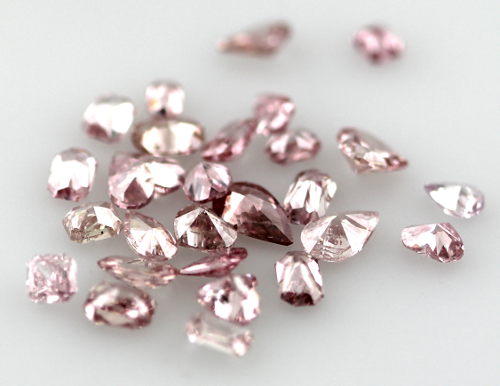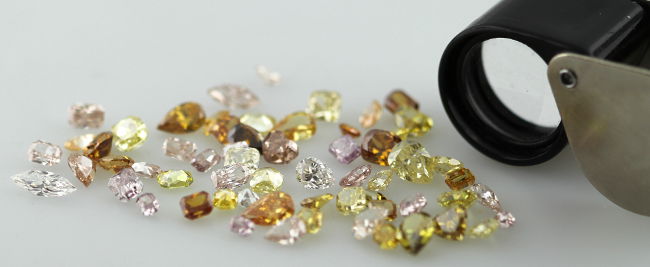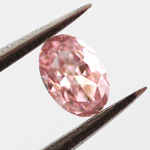Investing in Colored Diamonds – How to Choose Investment Grade Diamonds?
- Home /
- Diamond Buying Guides /
- Investing in Colored Diamonds
In our guide about diamond investment we shared with you all of the insights we have on the matter - the pros the cons and the risks.
The pros are portability, durability, inflation proof, psychology and expected increase in demands. The cons and risks are lack of price transparency, lack of tradability and time - diamonds should be considered for medium to long term investment.
We also emphasized all of the advantages of using colored diamonds for investment as opposed to regular colorless diamonds.
In this guide we will cover the technical aspects specifically related to investing in colored diamonds, what makes a colored diamond an investment grade diamond and how to choose this one of a kind diamond.
 Parcel of Rare Pink Diamonds
Parcel of Rare Pink Diamonds
What are investment grade diamonds?
As investors we look at the investment as an equation - on one hand what I am willing to risk and on the other hand what I expect to earn. Risks VS potential earnings.
For us, investment grade diamonds are diamonds that have some unique characteristics that can overcome or at least minimize the cons and risks involved in the investment and that have better chances to increase in price, to appreciate over time. By playing on both sides of the equation we dramatically improve our chances for success.
The beautiful thing about a natural colored diamond is that by definition the starting point is much better than in regular colorless diamonds - They are rare enough due to the fact that only 0.01% of the diamonds is a natural colored diamond (1 of 10,000 diamonds) and on the other side we see more and more celebrities with colored diamonds engagement rings that are constantly increasing the awareness and demand.
Another great advantage is that unlike colorless diamonds that can be found in every shape, size and color, each colored diamond is unique. When considering the 4Cs of diamonds and colored diamonds, naturally, an extra weight is given during the manufacturing process to the Color aspect. This is why every diamond is unique. For example, a slight change in the pavilion angles and the color of the diamond will turn out differently. So when the time comes to sell, if you have a good product someone is bound to buy it because he can't find it elsewhere. Can you really compete with a diamond manufacturer? Do you even want to try?
So…How to choose a colored diamond for investment?
Probably the best way for you to decide will be based on the budget you have. Within this budget you can decide (might be even wise) whether to split it into 5 x $5,000 diamonds or to buy one $25,000 diamond etc.
Colored diamonds are rare but if we need to split them into pricing levels (which are naturally a result for rarity levels) we'd split them as follows:
- Relatively Common Colored Diamonds – Browns, Greys, Fancy Yellows.
- Mid-level colored diamonds - Intense and vivid yellow diamonds along with some color combinations of orange diamonds.
- High Priced and rare colored diamonds – Pure Orange, Greens, Purples, Pinks and Blues.
- Red Diamonds - a level of their own.
Please note that even though we state above that brown diamonds are relatively common, there is nothing common (or cheap) about a 10 carat brown diamond with VS clarity.
Also keep in mind that this classification into groups is a very general one. There are hundreds of colored diamonds colors made out of combining the base colors and each is treated differently. You can read more about pricing and comparison to whites in our article - Are Colored Diamonds more Expensive?
Our goal as investors will be to find a diamond within our budget that is desired and known yet not too rare or too special so there will be a market for it. Also, there are some baselines, some guidelines, that from our personal experience we recommend to uphold (and things to avoid).
 Sorting Mixed Colored Diamonds
Sorting Mixed Colored Diamonds
Basic Specs and Guidelines for Investing in Colored Diamonds
Besides for the general instructions regarding how to buy investment diamonds like buying only GIA certified diamonds etc. there are certain technical specifications about the diamonds themselves that we recommend ensuring they exist (or do not exist):
-
GIA certificate
We have covered it before so I'll just say - make sure you have a GIA certificate. It is the only way to truly know what you are buying. Also, your buyer would want to see it as well. -
Fluorescence
The way we see it, fluorescence in yellow diamonds that are bought for investment purposes is a taboo - don't go there even with the price reduction that comes with it. However, in other colored diamonds is quite irrelevant. -
Clarity
From our experience, low clarity diamonds are harder to sell. When it comes to low clarity colored diamonds, they actually have their place, their clientele, but not as investment diamonds. Often, people really want an expensive color colored diamond like blue or pink or that they do not want to go with such a diamond beneath a certain size, this is when such diamonds come in very handy. This is also true about diamond collectors that wish to have as many colors of colored diamonds in their collection as possible and therefore willing to forget about clarity. However, since you are not a merchant holding hundreds of diamonds, the fact that these diamonds are harder to sell is a red flag.
Our recommendation -The best value and most commercial is the VS2. However we cannot always find exactly vs2 diamonds so here are the guidelines - when considering the lower and mid-range colored diamonds not going beneath vs2 (definitely not below si1), and with the higher end diamonds not beneath si1 or si2 that is eye clean. -
Diamond Cut - Diamond make
People tend to confuse between cut with shape. When talking about cut we refer to the quality of its polish (the precision in which it was cut). Does the diamond have fire and brilliance? Does it shine as it should? This is one of the most important things to check. If you buy online make sure to look at the diamond's picture and preferably also a 360 video in order to thoroughly examine it - do not rely solely on the certificate (I recommend going through our buying diamonds online guide and read the safety tips). -
Diamond Shape
Some shapes are more sought after than others and therefore will probably make the diamond easier to sell later on. Stay away from irregular shapes like a kite, triangular etc. In the more common shapes the ultimate is the round, and then comes the princess, cushion cut, oval and radiant, then pear shaped, heart shaped and marquise. Note that there are hardly round colored diamonds since it is harder to maintain the color in rounds (you usually "lose" one intensity degree due to the way light goes through round brilliants). So manufactures of colored diamonds would often prefer a cushion or oval. This is also why a round colored diamond will be much more expensive. -
Diamond Size - Carat Weight
If you consider the lower end colored diamonds such as fancy yellows and browns then try to stay above 1.00 carat. Even there, it would be most sensible to buy diamonds weighing next to the classic weight steps as it might be more sought after later on. For example, a 1.00 carat fancy yellow diamond makes more sense than an equivalent 1.30 carat yellow diamond which will also cost you at least 30% more. Here are several interesting steps: 1.00ct, 1.50ct, 2.00ct, 2.50ct, 3.00ct, 4.00ct and of course the 5.00 carat diamonds.
Regarding the higher-end diamonds such as greens, blues, pinks, purples and obviously reds - people go down in weight till even 0.15ct or less in order to be able to put their hands on, to afford, such gems. 0.13ct Intense Pink Diamond
0.13ct Intense Pink Diamond
There are amazing 0.15ct diamonds such as intense pink and vivid blue that are worth tens of thousands of dollars per carat that are snatched almost instantly. 15 points is OK. However, if possible, our recommendation is going above 0.20-0.25ct and if possible and you can afford it then even 0.50ct.
Heads up, diamonds prices go up exponentially along with the weight. A half a carat intense pink diamond can easily cost six times more than an equivalent 0.20ct this is because its price per carat is much higher and the carat weight itself is 2.5 times higher - multiply the two and there is your result. -
Diamond Color
Stronger is better! In yellow diamonds go above fancy yellows, try to get to Intense Yellow Diamonds. In the higher colors, fancy light will be a good entry point. A fancy light blue with obvious blue color is highly demanded because it is a lot more affordable (still not cheap) than fancy blue yet you still get a blue diamond. In Light and Faint colored diamonds the color is much harder to notice, especially in delicate colors like pink and green and therefore less recommended for investment.
Concluding Colored Diamonds Investment
Diamond Education
Going through our do's and don'ts above you are left with a limited yet wide range of possibilities that are left to your judgment. For your convenience, we have created a display section investment diamonds with diamonds we think are worth looking at for all the reasons mentioned above.
However, whether it is better to buy a 3 carat intense yellow diamond vs2 with no fluorescence or a half a carat fancy blue it is up to you.
No one knows now which has better chances to appreciate more in few years and which will be easier to sell.
But, as long as you follow our recommendations which are based on our experience, your decision will be an educated one.
Good Luck!
